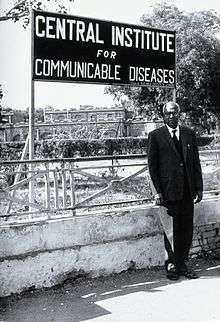National Centre for Disease Control
| Agency overview | |
|---|---|
| Formed | 1909 |
| Preceding agencies |
|
| Superseding agency |
|
| Jurisdiction | India |
| Headquarters | New Delhi |
| Minister responsible | |
| Agency executive |
|
| Parent agency | Ministry of Health and Family Welfare |
| Website |
www |
National Centre for Disease Control (NCDC) (previously known as National Institute of Communicable Diseases) is an institute under the Indian Directorate General of Health Services, Ministry of Health and Family Welfare. It was established in July 1963 for research in epidemiology and control of communicable diseases and to reorganize the activities of the Malaria Institute of India (MII).[1] Currently it has eight branches at Alwar, Bangalore, Trivandrum, Calicut, Coonoor, Jagdalpur, Patna, Rajahmundry and Varanasi to advise the respective state governments on public health.[2] The headquarters are in Sham Nath Marg in New Delhi.
History

The origin of NCDC can be traced back to Central Malaria Bureau, which was established at Kasauli, Himachal Pradesh, India in 1909. It was renamed as the Malaria Institute of India in 1938 and in 1963 renamed as the NICD.[3]
The reorganized Institute was established to develop a national centre for teaching and research in various disciplines of epidemiology and control of communicable diseases which is under affiliation with Guru Gobind Singh Indraprastha University, Delhi. The Institute was envisaged to act as a centre par excellence for providing multi disciplinary and integrated expertise in the control of communicable disease. The Institute was also entrusted the task of developing reliable rapid economic epidemiological tools which could be effectively applied in the field for the control of communicable diseases. The objectives of the Institute broadly cover three activities viz., training, service and operational research in the field of communicable diseases and their prevention and control in the country.
The Centre for AIDS & Related Diseases was established at National Institute of Communicable Diseases (NICD) as a National Reference Laboratory as per NACO guidelines in the year 2002. Prior to this it had existed as AIDS Reference Laboratory since 1985, one of the first reference centers in India, which started surveillance of HIV infection in the country.
On 30 July 2009, it was named as National Centre for Disease Control.[4]
Divisions
NCDc has eight divisions under it namely[5]
- Epidemiology division
- Training and malariology division
- Helminthology division
- Biochemistry and Biotechnology division
- Microbiology division
- Medical Entomology and vector control division
- Zoonosis division
- AIDS division
Activities
Doctors from NCDC had been previously summoned to investigate potential outbreaks of diseases including suspected cases of Pneumonic plague in Punjab in 2002,[6] SARS outbreaks in 2004,[7] meningitis outbreak in Delhi in 2005,[8] and avian influenza in 2006.[9]
Global Disease Detection (GDD)
The NCDC in collaboration with the Centers for Disease Control and Prevention has set up the Global Disease Detection Regional Center in New Delhi, India.[10] This will lead to long-term public health collaboration between the Government of India and the United States in many areas including establishing high quality research and surveillance on important human infectious diseases, establishing the Indian EIS (Epidemiological Intelligence System) program, and developing the NCDC as an international nodal agency in South Asia.
See also
For similar agencies elsewhere, please see list of national public health agencies
References
- ↑ About NICD
- ↑ About NICD branches
- ↑ IN FOCUS:Shaping health experts and aiding research
- ↑ Rs 510 crore to revamp NICD
- ↑ Organization chart
- ↑ Tests point to plague:One more death takes toll to four
- ↑ Tests point to plague One more death takes toll to four
- ↑ Fatal meningitis strikes Delhi
- ↑ No human case of avian influenza in India
- ↑ http://www.ncdc.gov.in/index3.asp?sslid=524&subsublinkid=307